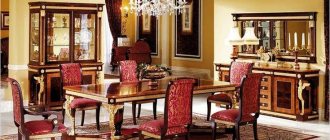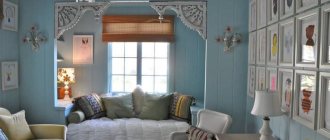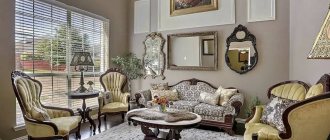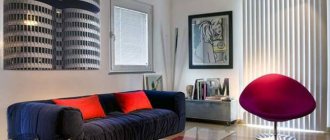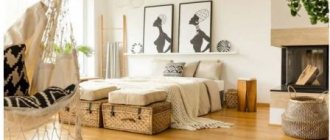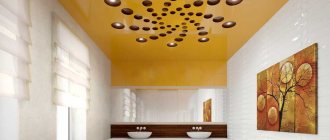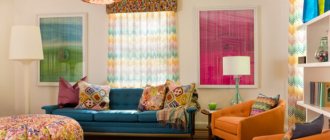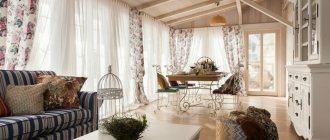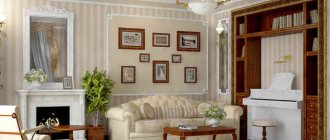Features of the Arabic style
- Arabic design stands out from others due to its religious component. The Holy Quran prohibits the presence of sculptures and picturesque images of people and animals in the design of a home. Therefore, when decorating premises, mosaic graphics, patterns of geometric lines and shapes, exquisite and complex ornaments are used, and floral themes are successfully used.
- The panels on the walls are made in square, diamond or hexagonal shapes, even the carpets and floor tiles are decorated with combinations of geometric shapes. The room must have a clearly marked and decorated center.
- The most popular architectural forms of the Arabic style are the sphere and the semicircle, combined into complex structures, resulting in exquisite arches and majestic window openings.
- By tradition, the oriental style does not imply the presence of familiar doors. The space is delimited by curtains, arches and semi-arches, colonnades. Arabic design implies a certain privacy, so it does not have the trendy European open floor plans.
Arabic interior in your home
In order for your home to breathe the atmosphere of the East, it is absolutely not necessary to remodel the entire interior. It is enough to highlight the main elements, and you will feel like a real Arab sultan in harsh domestic conditions. We recommend focusing on carpets, arches, pillows and lighting.
The standard wallpaper on the walls will have to be replaced with Arabic wallpaper, made of moire and velvet. The motto of the oriental interior is more inspiring colors!
Remember that living conditions here and in eastern countries are strikingly different. And some things simply won’t be implemented for a number of reasons. For example, stone floors save Arabs from the heat. Our climate is completely different, so you can do without stone. It is enough to cover the wooden surfaces with a good Arabic carpet.
Tip: First, decorate one room in Arabic style. Look at the result and only then breathe the oriental atmosphere into the entire apartment.
When purchasing carpets, pay attention to wool blends and wool products with a dark background. These carpets are inexpensive and fit the theme. Columns and arches will help divide a large room into zones. If the room is small, then you can limit yourself to figured niches and semi-columns.
The Arabic style has a peculiarity - it does not tolerate a large amount of furniture
. Do you want to get closer to the East? Then remove armchairs, chairs, cabinets and high dining tables from the room. They do not fit into this direction in any way. And true oriental furniture is ottomans, large sofas and low tables decorated with inlays. At the table, Arabs sit on soft cushions. Chairs are inappropriate here.
Wardrobes are rarely present in oriental interiors - Arabs store clothes and things in special niches with aesthetic wooden doors. Pay attention to the lamps. They are given a special role. There are many forms and varieties - there is plenty to choose from. Arabian lighting should be soft and subdued - it was in such conditions that the famous Queen Scheherazade read her fairy tales.
- If your living room has high ceilings, then a wrought iron chandelier will fit perfectly into the interior.
- Arab sultans prefer narrow lancet windows. But this is for palaces. And in an ordinary house, the best option would be a figured niche in front of a large window. You can also cover everything with curtains. It will look original - the window will resemble the entrance to a tent.
- Another key point is that Arab rooms do not have doors. The opening is covered with either heavy curtains or carpets.
An important touch is accessories, which serve as an excellent addition to the overall atmosphere. The list of them is huge. This includes items such as chess, birdcages, jugs, hookahs, dishes, vats and other small but important attributes of oriental life.
History of origin
The Arab way of life is based on religion, which permeates all areas of Eastern life. Therefore, she did not ignore the rules for designing and decorating living spaces. The first thing that distinguishes the life of the East is the secrecy of the internal structure of the family. This is precisely related to the fact that for a long time the principles of the Arabic interior style were unknown to the broad masses of the world's population. And only in the middle of the 19th century Europe discovered the wealth of oriental decoration.
- Unlike the constant alternation in interior design styles that are fashionable at different periods of time in the European part of the world, the Arabic style is very conservative and dictated by loyalty to tradition, and therefore has not changed for many centuries. This is not only its design, but also its historical value.
- The second distinctive feature of oriental interiors is that not a single animate creature is reflected in any of the ornaments, lush patterns, or ornate elements. This rule is prescribed by the Muslim scripture. That is why the variety of oriental paintings is so rich in cyclical ornaments and patterns.
Following the traditions of the nomadic way of life still dictates peculiar rules in the decoration and design of the oriental interior: this is the wealth of textiles, the decoration of rooms in the form of tents with the help of canopies and many pillows and carpets, which were once spread right on the sands of the deserts during times of long wars or wars. trade trips.
The Arabian-style room is decorated with oriental patterns, carpets, colorful pillows and many accessories.
Furniture in oriental style
Furniture was rarely used in traditional Arab culture and consisted primarily of leisure items and safes used to store clothing, textiles, and other personal items. The term sofa comes from the Arabic word sufah, which means bench or platform. Wooden furniture is usually decorated with intricate carved abstract and geometric patterns. Parts of pieces of furniture were cut, and the gaps thus created were filled with various types of wooden inserts, such as walnut, rose, lemon or peach.
Furniture in dark colors, with classic and carved lines, contrasts with light walls, while leather or mosaic stools and silver decorations complement the decorative theme. The Arabic style is full of pieces for every square centimeter and is filled with a whole series of specific fancy decorations. These combinations, which have remained virtually unchanged for centuries, are called arabesques , which means a symbiosis of geometric and floral shapes inscribed in strict forms.
Unlike the Western world, seating furniture was not an element of Arabic decor until a few decades ago. Floor cushions, small benches or platforms were used. In addition to chairs and sofas, Arabic furniture usually includes polygonal tables, partitions, carved doors and drawers.
Textile
Perhaps the most important element in Arabic design is the use of colored textiles in a wide variety of patterns and textures. Use layers of beautiful fabrics and textiles, including Persian rugs, pillows, floor cushions, wall hangings and curtains. In many Arabic-style interiors, the walls and ceilings are covered with fabrics, creating a tent-like effect. Textiles can be placed above tables, drawers and benches or framed as wall art.
Luxurious fabrics include organza, brocade and velvet in a combination of narrow stripes and wide or zigzag patterns, Arabic calligraphy and various abstract or geometric patterns. Add fringe and tassels to pillows and drapes, or look for pieces that already have them.
Using layers of luxurious fabrics, textures, colors and patterns is essential. This can be done by resorting to heavy curtains, rich upholstery, Persian rugs, plush and floor cushions, lustrous and floating silks, fine satins and soft and fine cashmere that enliven every corner of the room.
Accessories
Fine copper tea sets, brass or nickel trays, decorated ceramic vessels such as vases and urns, inlaid mirrors, stools, lanterns, beaded lamps, pillows, stylish hooks, high-necked vessels are staples when it comes to complete the decor in the Arabic style.
The main feature of the Arabic style is the absence of any indication of images with people and animals, and the Koran prohibits their use in any accessories. Therefore, do not use sculptures or other similar objects. But instead, you can take inspiration from oriental tales, use images with plant inscriptions and geometric shapes, or their famous calligraphic masterpieces, which often quote passages from holy books.
Interesting samovars, tea sets, and gold accents receive pride of place here. Other popular accessories include porcelain, semi-precious stones or garnishes. Metal or wooden chests, metal tables, taftals, mirrors and benches should not be missing. Look for interesting items that remind you of the wonderful Arab heritage.
Boxes or chests can be used as coffee tables. Don't slow down when decorating in Arabic style, this allows even the most whimsical visions to make room for decoration. Use opulent chandeliers, enchanting lanterns, ornate tapestries, sumptuous rugs, cascading plush curtains, extravagant furniture, textured layers of fabric, and don't forget pieces with lavish gold accents.
Oriental style is also defined by the use of furniture that has certain (family) traditions. For example, an antique library could fill a living room. Wicker beds are also high-impact items. For added Arabic style, you can use awnings and cushions in bright colors and different shapes to decorate the room.
It may look dated or too rustic, but a wall rug is always a fashion accessory. Made from natural fabrics with special prints, the carpet for wall decoration clearly resembles oriental style.
To define the oriental style, you can choose ivory objects. Thus, a lamp or a colorful painting whose frame is made from this material are just some of the objects that you can use to create an oriental ambiance in a room. A chandelier is an integral part of living room decoration. You can choose gold with lots of decorative details and curved lines.
Lighting
The intricate chandelier we mentioned earlier is always the focal point of an Arabic design, very large and bold, which will open up the space. Metal lamps suspended from the ceiling or placed on the floor add charm and mystique.
Candles are also used. The oriental interior is bright, but it is artificially lit. In modern styles, Arabic design rejects sunlight, considering it useless, so much attention is paid to curtains, stained glass and blinds. They can keep anyone away from prying eyes and effectively complement themed interiors without ruining their authenticity. So use dim, confusing light.
Moroccan and Turkish are perhaps the most famous models of this new style of interior design. There is also variety, which ranges from rustic Bedouin-style decor to lavish layered designs that evoke images from Arabian Nights legends.
Modern Arabic interior design is actually quite minimalist and it has not gained popularity like the one we have presented to you today. When we think of Arabic style interior design, we can only associate it with opulence.
History of style
Nowadays, this trend is very popular all over the world, but few people know that until the 7th century no one had even heard of it. Its formation was actively promoted by the rulers of those times, who wanted to see around them beautiful, rich decorations that corresponded to their religion. So let’s say they avoided using figurines or images of living creatures in decoration, since the scripture says that they should be “avoided.” That is why local creative individuals invented characteristic Arabic prints, which were used to decorate palaces everywhere. As for its popularity in Europe, it dates back to around the 19th century, when people began to show serious interest in the Arab lifestyle.
Character traits:
- An incredible number of different textile items;
- Arched door and window openings;
- Wall niches;
- Massive lighting fixtures;
- Wood carving;
- Forged items;
- Heavy fabrics for curtains;
- Mosaic on the walls and floor;
- Painting on walls and furniture;
- Poufs, couches and chaise longues;
- An abundance of gilded objects, as well as silver and bronze.
Decoration Materials
▫ The ceiling is decorated with paintings, multi-stage structures or decorative panels. Coffered ceilings, multi-level with lighting or suspended mosaic coverings are successfully used.
▫ The walls are painted or wallpapered. When painting, one color is used or intricate oriental script is applied to wet plaster. The wallpaper should have a geometric or floral pattern or fabric imitation. ▫ Floors are usually finished with tiles or mosaics. The tile size is usually small, 10x10 cm, or less. ▫ Wood is used to decorate window and door openings. Timber frames, shutters and grilles add a special accent to the room. To live in a house decorated in a truly Arabian style, you need to have a special worldview. The East is bliss, a calm rhythm of life, comfort, the slow passage of time, which is hardly possible in the modern world. Therefore, the Arabic style in the interior requires a respectful and careful attitude, the introduction of certain philosophical and religious traditions and rituals into life.
Textile decoration
Unlike furniture, there are a lot of textiles in the Arabic style. Striped and patterned pillows scattered throughout. There are bright colorful bedspreads on the sofas, ottomans and armchairs.
It is impossible to imagine this interior without soft oriental carpets. Yellow, red, golden - they are on the floor, armchairs and sofas, hanging on the walls or lying in a stack.
Window openings are often half covered with light tulle and thick silk, velvet, or organza curtains. The curtains have an oriental pattern and many folds. The tiebacks are made of twisted silk cord, at the ends of the brush. The upper part of the windows is decorated with a lambrequin. Thick curtains also hang on the doorways.
More: Modern European style in the interior: minimalism and functionality
Textiles - special attention
Oriental style without carpets – no, it’s something else. This textile product should be given due attention. They are all around: on the walls, sofas, on the floor.
If the curtains are on the windows, then they must be heavy, with a lot of draperies and folds, with tassels along the bottom edge. Both curtains are intercepted in the middle with cords and secured on both sides of the window. The top is decorated with a lambrequin or bandeau.
History of the Arabic style in the interior
The Arabic style was formed over many centuries and for many years was carefully protected from the eyes of Christians. Only a few European travelers had the opportunity to see with their own eyes the luxury of the interior decoration of the palaces of the sultans and viziers. Until the beginning of the 18th century, the Arabic style in the interior was widespread only in the countries of the Middle East and North Africa.
But with the beginning of active penetration of Europeans into these territories, the situation began to change. Upon returning to their homeland, many successful colonialists brought with them items of Arabic decor and tried to recreate a luxurious oriental interior at home.
Gradually, the Arabic style gained popularity in Europe, especially among the wealthy bourgeoisie in big cities. The fashionable oriental design direction could not compete on equal terms with traditional European interior styles, but it always had its adherents.
In the second half of the 20th century, many conservative Arab countries began to pursue more open policies towards foreigners. Large-scale development of the vast reserves of Middle Eastern oil has caused a rapid improvement in the living standards of local residents.
Mass construction of comfortable oriental-style hotels has begun in the United Arab Emirates, Saudi Arabia, Kuwait and other countries in the region. The Arabic interior style has become not just a popular design trend, but also an obvious standard of luxury. And among its adherents we can safely include many VIPs, show business stars and major politicians of world importance.
On the online platform Very Important Lot, visitors can take part in art auctions and purchase antiques. Here you can directly buy paintings for room decoration from talented contemporary authors.
General characteristics of the Arabic style
The Arabic style does not provide for empty surfaces - everything should be decorated with a pattern. According to the laws of Islam, you cannot place canvases or paint walls in your home that depict animals, people or plants. The painting is an outlandish pattern consisting of phrases from the Koran, and decorated with additional ornaments.
A distinctive feature of Arabic patterns is clear lines with a description of the smallest details. The background of such arabesques should be a rich color: crimson, black, red, emerald.
The Arabic interior style contains a huge number of textile elements:
- All kinds of decorative pillows. They should be of different sizes and different shapes. They are made of silk and chintz, the surface of the material is painted with golden embroidery.
- Carpets with thick painted patterns are used as floor coverings. One room can have several carpets of different colors. Sometimes they have fringe or tassels.
- Tile is the main floor covering in any room.
- Carpets are also used to decorate walls. In concept, they are the same as their floor-standing counterparts.
- Light curtains made of transparent and translucent material that zone the room into space for relaxation, work and other activities.
- The windows are decorated with thick curtains with oriental motifs, which are additionally equipped with lambrequins and laces.
- The color palette is contrasting, but at the same time bright. Any decorative element combines several rich shades to create an intricate pattern.
Related article: Main characteristics of high-tech style in an apartment (+38 photos)
This is the main motif of the Arabic decoration of the room. In addition, small upholstered furniture is used. The entire space of the room should be filled as much as possible with decorative elements and furniture.
On video: how to decorate an interior in oriental style
Lighting
The Arabic style interior is characterized by rich lighting: large wrought iron chandeliers, various lamps, wall and table lamps, sconces, candelabra. All light sources have a complex design and emit a mysterious golden glow, which adds richness to the color of draperies and interior fabrics. Dim, diffused light provides an intimate and relaxing interior atmosphere. Aroma lamps with oriental spices fill the air in the room with sweet aromas.
For those who love to create
If you want to create something with your own hands, then in an Arabic-style interior you will have a place to express yourself. The simplest thing is to create a large number of pillows, selecting fabrics by color, pattern, texture. They can be trimmed around the edges with braid.
Turn the window into something like a tent. Create lambrequins or trim, assemble curtains beautifully by choosing two matching fabrics, don’t forget about the cords. The top of a canopy over a bed or sofa can be attached to the ceiling.
You can create a pointed arch by cutting out a base from plasterboard, covering it with a thin layer of putty and painting it. Use a jigsaw to create openwork cabinet doors or a screen from plywood.
As for painting with patterns, there is no limit to imagination. Just follow a number of rules. First, draw a geometric pattern, then decorate it with floral patterns, clearly drawing all the details. Don't copy living plants, but invent your own.
Photo of interior in Arabic style
If you cannot imagine your home without the noisy range of Arabic decor, but cannot definitely make a choice in favor of a specific design, the Arabian fairy tale captured in the photo in a modern version is designed to help you.
Bedroom
It is the bedroom that is the embodiment of Arabic grace and a blissful atmosphere of complete relaxation.
A bedroom in an Arabic home is a concentration of grace, comfort and splendor
Living room
The living room space in the Arabic style is designed to demonstrate luxury and wealth, and even somewhat demonstratively. An abundance of gilded accessories, expensive handicrafts, a variety of large-scale space design - all these are necessary components of an Arabic home.
Living room in Arabic design invites you to spend time slowly and mentally
Kitchen
The comfort of a family hearth begins in the kitchen. The Arabic style in the kitchen emphasizes the richness of kitchen utensils, their value and exclusivity.
An Arabic-style kitchen combines the bright colors of ceramic mosaics, the comfort of luxurious textiles, and the elegance of oriental utensils.
Bathroom
Famous patterns and mosaics of Arab countries are extremely popular in bathroom decoration. It is in this style that golden or bronze colored plumbing fixtures, massive taps, towel holders, curtain rods and other plumbing accessories are appropriate.
An Arabic-style bathroom can be a real work of oriental art. And this is reflected in the luxurious interior details.
Oriental style in the interior - colors and materials
The color range is extremely rich - from radiant yellow, bright red and bright orange to azure blue - and the materials are precious and natural - silk, organza, cotton or brocade . The color palette in the Arabic style can be as varied as in any other style. The most common colors are warm neutrals.
Using warm neutrals for your walls will allow accent colors and patterns to stand out even more. You can also add cool tones like turquoise and sparkling emerald greens. A bright shade can be used on an accent wall such as orange or Moroccan red.
Use textured paint or add texture with a powder additive that will give the wall a tile-like texture. You can get a rough surface for your walls by using drywall, which will help you create an uneven look. Moroccan patterned wallpaper can do wonders for adding depth and focus to a room, and shelves placed on the wall can also create an interesting pop of color as well as adding useful storage space.
Other colors you should consider: beige, almond, wheat, curry, salmon, cinnamon, plum, chocolate, purple, gold, coral, rust, terracotta, ocher, olive and blueberry . In Arabic style you can never have enough flowers.
Even a souvenir or accessory, no matter how small it may be, will reflect oriental traditions. The color combinations are also shocking. You will find mixtures of blue with cherry, brown with violet, plum with ocher, terracotta with blue, all at one end, with intense gold (the color of prosperity and luxury). We can say that this is an obsessive cause that occurs on all surfaces: in curtains, on carpets, on the edges of mirrors and even on walls decorated with gold bas-reliefs.
Arabs do not like smooth surfaces and monotonous patterns. You can decorate the walls and ceilings with wooden mosaics, forming geometric shapes, or you can choose depending on your budget.
You can choose traditional white, which will give the space a fresh and shiny look, or neutral colors in shades of sand dunes, desert and sunsets. Either way, keep the colors in the main palette and don't overcrowd the walls, as the structure should allow the colors to flow throughout the space and depending on the accessories you choose. Do everything in moderation and never think that if you don't have enough flowers, you haven't achieved your goal.
Instead, for an authentic "look" you can use layers. Throw in different sized pillows here and there, mix colors and textures, and add a variety of fabrics and/or rugs. Another tip: try to match the color of the floor to the color of the walls and ceiling. This will help you stay on track.
Arabic style furniture
In the Arabic interior there is not much furniture familiar to the “European”. Instead of chairs, for example, pillows are used. Armchairs, sofas, and ottomans must be covered with colorful satin bedspreads.
Interior items are made of hard wood and decorated with carvings and inlays. Among them are necessarily present: - A low sofa with a spacious sleeping area; — Ottoman; — Low cabinets with small capacity; — Many bedside tables of various shapes, often decorated with carvings.
Modern Arabic style in the interior
Authentic Arabic style in the interior of small apartments rarely looks good. However, if you really want to have such a design for your living room, bedroom, bathroom or kitchen, choose an eclectic option.
You can create a minimalist monochrome design in your home and give it an Arabic touch. For this purpose, it is enough to use a couple of original authentic parts.
This could be an original lamp, a carpet with bright arabesques, a vase or a hookah. A “canopy”, which is curtains draped in an original way on the wall, is also perfect.
And don't forget about the screens. This piece of furniture will become a real assistant when zoning a studio apartment.
An original technique and arrangement of an artificial arch with pilasters on one of the walls, for example, on the one where the television panel is hung.
Bedroom decoration
An Arabic style bedroom features a variety of textiles and materials. The walls are decorated with relief plaster and wood arabesque. Decorative arches and columns, which are decorated with textile elements, predominate. Mosaic tiles are covered with painted carpets. The walls are usually covered with thick wallpaper or painted with matte paint. The preferred colors are red and gold, as they go well together. Pastel shades and white are used less often - it all depends on the residents.
In addition to columns and wooden inserts, the walls are decorated with built-in niches. These recesses on the wall are intended for storing lamps, vases, figurines, boxes and other items.
The ceiling is often decorated with carvings or painted. At the present stage, a regular stretch ceiling can be used. Furniture should be soft, comfortable and low, in particular this applies to the bed. It is this piece of furniture that is often placed in a built-in niche in the wall. Chests of drawers are used instead of a closet. Lighting in an Arabic-style bedroom should be dispersed around the entire perimeter. Therefore, a huge number of spotlights are used.
In the bedroom, you can place pillows for decoration and textile elements in the form of curtains around the bed. The latter can be made of dense dark-colored material with gold or silver painting.
Photo of Arabic style in the interior
Accessories
What needs to be added to the design of the room to recreate the Arabian image in it? • Lamps. They are located on the walls, on tables, and descend from the ceiling. Manufacturing material – colored glass, openwork metal.
• Dishes. Ceramics, metal - sets for water and wine, hookahs, and vessels for washing hands are made from these materials. They are usually decorated with inlay and painting. • You can advantageously emphasize the sophistication of the room by using vases, vessels, copper trays, hookahs, musical instruments, chess, richly bound books, wood and wrought iron products.
Furniture
If you are decorating your room in an Arabic style, then remove all chairs and armchairs, as well as bulky cabinets and standard-height dining tables. These objects are alien to eastern peoples.
There is little furniture in the oriental interior. These are, first of all, large sofas and ottomans with a wide variety of pillows. The tables are low, of non-standard shapes, made of wood and decorated with inlays. They often look like big spreads. At such tables it is customary to sit on cushions.
If there are cabinets, they are light and openwork. Most often, niches in the wall are used for storing things, closed with wooden doors with carved patterns.
